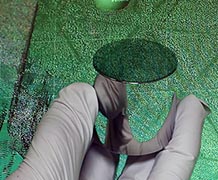Presented by the Photography Department at Camberwell College of Arts and hosted by the Graduate School at Chelsea College of Arts on 4 December 2015, Shadow without Object was a one day symposium featuring ten presentations by a wide range of international speakers from contemporary art, art history, museum conservation and particle physics. Departing from the notion of photographic ‘indexicality’, which conceives of the photograph as a physical trace or imprint of its subject, the diversity of presentations inspired a rethink of photography’s relationship to the material world.
BA Photography lecturer Bernd Behr, gives us an overview of the day.
The day started with Peter Geimer, professor in Art History at Freie Universität Berlin, giving his keynote presentation on a history of photographic appearances, exploring particular moments when accidents turned into images, where “artefacts become facts”. Duncan Wooldridge, course leader for BA Photography at Camberwell College of Arts, followed with a paper unpacking notions of ‘realism’ and how we increasingly conform our lives to the conditions of photography in social media.
Louisa Minkin, course leader for MA Fine Art at Central Saint Martins (CSM), delved into a pre-history of 3D scanning to reflect on the hollow body of data capture in her current work appropriating cutting-edge imaging processes used in digital archaeology. I then gave my paper, which speculated on the future implications of the provenance shared by sprayed concrete, taxidermy and cinematography.
Daniel Rubinstein, course leader for MA Photography at CSM, located the index in the latent image within undeveloped film which is paradoxically destroyed through its processing and becoming visible. The latent image also figured in LCC Senior Research Fellow Jananne Al-Ani’s presentation on her photographic and film work surrounding archaeological sites in contested regions, highlighting the role of the sun’s movement in producing these sites for the aerial eye. A similar object-image continuum was explored by Betty Sacher, PhD candidate in museum conservation at UCL Institute for Sustainable Heritage, in her presentation on accelerated fading techniques performed on museum collections, recasting the object as a light-sensitive image developing over time.
The second keynote and final presentation of the day by Michael Doser, research physicist at CERN in Geneva, zoomed out even further into deep time considerations of light, particles and antimatter within the universe.
While the symposium included presentations by a number of artists and writers teaching across UAL, highlighting the incredible range of research specialisms available to students, it also featured current postgraduate students and recent alumni, including Sam Burford, PhD candidate at Chelsea College of Arts, and Giacomo Raffaelli, who graduated from the BA Photography course at Camberwell College of Arts in 2014. Sam proposed a compelling argument for the correspondence between physical and synthetic light in rendering images, while Giacomo gave a performative lecture on his recent project attempting to 3D scan the kilogram standard at the National Physics Laboratory, “the most perfect of analogue objects.”
The theme of this symposium reflects an on-going interest among students on the BA Photography course at Camberwell College of Arts, many of whom come to the course to explore how an expanded notion of photography can operate within a fine art studio practice. This involves exploring and redefining the material forms and gestures that photography can inhabit, in contrast to the seemingly dematerialised experience of our screen saturated lives. However, this material exploration is not based on a nostalgic longing for an older model of analogue photography, rather a curiosity-driven embrace of the hybrid, sticky relationship between analogue and digital media that perhaps more accurately addresses our daily encounter with images.

Image credit: Panel discussion, from left to right: Jananne Al-Ani, Betty Sacher, Giacomo Raffaelli, Duncan Wooldridge, Peter Geimer, Michael Doser, Daniel Rubinstein, Louisa Minkin, Bernd Behr, Sam Burford.
Accompanying the symposium was a workshop for a group of postgraduate students from across courses as diverse as MA Fine Art Digital and MA Printmaking at Camberwell College of Arts, MA Fine Art, MA Textile Design and MA Graphic Design Communication at Chelsea College of Arts, as well as MFA Fine Art at Wimbledon College of Arts. The workshop explored a hybrid photographic process involving digitally sourced images printed as traditional cyanotypes, one of the earliest forms of photography.
The workshop was led by Peter Gosnell in the Photography Resource at Camberwell College of Arts, building on his extensive research into this specialist process and enabled by the custom-built facilities he has developed. For some of the students, it was their first time to work with images in such a hands-on way, having worked predominantly through screen-based interfaces before. This immersion in the materiality of an image was enabled by the analogue photographic facilities that Camberwell College continues to support, with this workshop being just one of a number of ventures in the resource that seek to explore the potential of traditional photographic processes intersecting with contemporary, digital workflows.
Follow the links below for more information:
Shadow without Object Symposium



